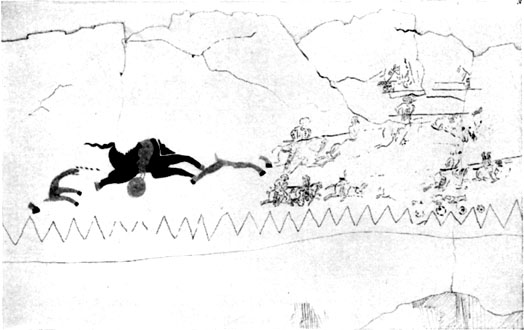
|
|||
|
|
|||
|
century A.D. and to regard it as the production of a resident of
Dura. How and when could a citizen of Dura, a Roman fortress, glorify
in the Iranian style a Parthian or a Sassanian victory over anybody,
much less over Romans? In view of this I ventured to suggest years ago
that the battle of the drawing represented the battle of Edessa, and
that it was made by a soldier of the Sassanian army when that army
occupied the half-ruined Dura for a while, after the battle of Edessa.
FIGURE IThis interpretation does not satisfy me any longer. No trace of evidence pointing to such an occupation has ever been found at Dura, and there is no visible reason for supposing that such an occupation ever took place. Dura with its ruined walls, never repaired after A.D. 256, was of no strategical value either for the Romans or for the Persians. Could we not therefore regard the unfinished drawing as a work of a soldier of the detachment of the Sassanian army which occupied Dura for a short time in A.D. 253? Is perhaps the battle represented the battle of Barbalissus? One may object: why was this drawing not destroyed after the retirement of the Persians from Dura? This is not a serious objection. The drawing was made in one of the many private houses of Dura, that is to say in an obscure place and the owner of the house may have cared little to efface the unfinished drawing, of which the meaning may have remained a mystery to him (the explanatory inscriptions of this drawing are written in Pehlevi).75 |
|||
|
|||
|
|
|||
|
Created by the Digital
Documentation Center at AUB
in collaboration with Al
Mashriq of Høgskolen i
Østfold, Norway. 990203 PN - Email: hseeden@aub.edu.lb |
